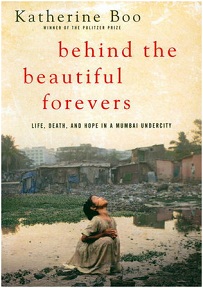by Katherine Boo
Katherine Boo’s Behind the Beautiful Forevers is in many ways an astonishing piece of work. Yet it’s also the type of “nonfiction” narrative that triggers nagging doubts (thanks a lot, James Frey).
The good. Boo spent three years recording the lives of slum-dwellers at Annawadi, a squalid settlement adjacent to fancy tourist hotels and Mumbai’s international airport. Boo avoids sentiment and, in depicting a world so harsh, unforgiving, and corrupt, has no need to embellish the facts. (But does she? See below.) She uncovers a small slice of poverty and in the process sheds volumes of light on income inequality in India.
The suspect. Imagine this: A group of male street-toughs, all of them teenage thieves or scavengers, are gathered on a corner. They discuss the sort of things that young boys discuss: girls, music, movies. They spot a white woman who is middle-aged, well-educated, privileged – and American. “Hey lady,” say the boys, “come join us and we’ll share our secrets and dreams with you, and treat you like just one of the guys.” See the problem? And yet Boo manages to probe the innermost thoughts and dreams of these kids. Great journalism, or creative license?
In an author’s note, Boo proffers a fairly convincing explanation of the techniques she used to get Indians like those boys to open up. In a separate interview, Boo calls narrative nonfiction “a selective art.” That leaves the reader with a choice: buy into the reporter’s “selective art” … or not.
© 2010-2024 grouchyeditor.com (text only)

